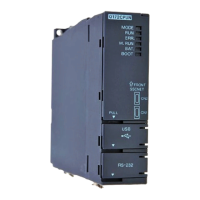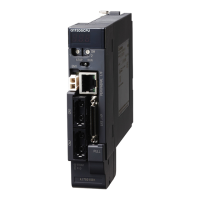6 - 4
6.2 Fail-Safe Circuit
6
PREPARATORY PROCEDURES AND SETTING
6.2 Fail-Safe Circuit
WARNING
Configure safety circuits external to the C Controller module to
ensure that the entire system operates safely even when a fault
occurs in the external power supply or the C Controller module.
Failure to do so may result in an accident due to an incorrect output
or malfunction.
(1) Configure external safety circuits, such as an emergency stop
circuit, protection circuit, and protective interlock circuit for
forward/reverse operation or upper/lower limit positioning.
(2) If the following status (a) or (b) occurs, the system will behave
accordingly.
(a) When overcurrent or overvoltage protection of the power
supply module is activated, the outputs (Y) from the user
program and writing to the buffer memory are disabled, and
all outputs are turned off.
(b) When the C Controller module detects an error such as a
watchdog timer error by the self-diagnostic function, the
outputs (Y) from the user program and writing to the buffer
memory are disabled. Whether to hold or turn off all outputs
can be set by parameters.
All outputs may turn on when an error occurs in the part,
such as I/O control part, where the C Controller module
cannot detect any error. To ensure safety operation in such a
case, provide a safety mechanism or a fail-safe circuit
external to the C Controller module.
(3) Outputs may remain on or off due to a failure of an output
module relay or transistor.
Configure an external circuit for monitoring output signals that
could cause a serious accident.
In an output module, when a load current exceeding the rated
current or an overcurrent caused by a load short-circuit flows for a
long time, it may cause smoke and fire. To prevent this, configure an
external safety circuit, such as a fuse.
Configure a circuit so that the C Controller system is turned on first
and then the external power supply. If the external power supply is
turned on first, an accident may occur due to an incorrect output or
malfunction.
For the operating status of each station after a communication
failure, refer to the relevant manuals for the network.
Incorrect output or malfunction may result in an accident.

